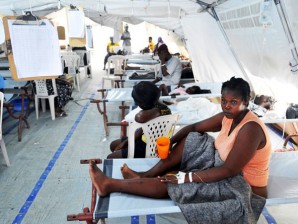
New Cholera patients admitted to the MSF (Médecins Sans Frontière)(Doctors Without Borders) clinic on November 7, 2012 in Delmas, Haiti where they were treated for Cholera. AFP PHOTO / THONY BELIZAIRE
NEW YORK — The group Doctors Without Borders has aided victims of war and disease in countries like Sudan, Haiti and the Democratic Republic of Congo.
Now, they are on their first mission in the United States — helping victims of Sandy, the megastorm that brought historic destruction to the New York metropolitan area.
By last Saturday, medical teams were on the ground in the Rockaways, a hard-hit section of Queens, as well as Staten Island, New Jersey and Brooklyn.
The doctors, nurses and medical students provide free medical evaluations to residents still without power, and help them fill and pick up prescriptions they might otherwise go without.
While noting the environment was “apples and oranges” compared to many of the locations Doctors Without Borders has worked, media relations manager Michael Goldfarb said there were gaps in health care after Sandy that the organization could address.
“There are real needs here and we’re doing our best to try to meet them,” he said. “There are vulnerable people here.”
In Far Rockaway, where a crew of four doctors, one registered nurse, four medical students and several other volunteers were working from a makeshift clinic in the first-floor laundry room of an apartment building, police direct traffic because street lights have gone dark.
There are National Guard trucks on the streets, and litter left behind where floodwaters receded.
Gas rationing in New York City began Friday, with drivers only able to fill up on even or odd days depending on the number at the end of their license plate – but that was of little use here.
At abandoned gas stations, cones and caution tape alerted motorists that they should move on.
Candice Humphrey, 28, lives in Brooklyn and never thought the first place she would work with Doctors Without Borders would be her own backyard.
A nurse practitioner who started training with the organization in September, Humphrey is awaiting her first placement overseas.
In Queens, she has provided home visit-type health care to residents in buildings such as one apartment complex that had no electricity and no running water above the fifth floor.
Some residents on upper floors “are essentially trapped,” she said, particularly the elderly, and those with knee or back problems that make it impossible for them to walk up and down stairs.
“We are seeing a lot of people who are running out of their medications,” Humphrey said. “People with diabetes, type 2, HIV, high cholesterol, other chronic health conditions that are not getting the medications that they normally would be taking because their supply chain has been broken.”
Louis Nelson, the handyman for the building where the clinic is set up, has been walking up and down the stairs to fix broken drainpipes and other building issues and figured he’d stop by to have his blood pressure checked.
When New York University medical student Steffen Haider took his blood pressure and discovered it was high, Nelson said he would make an appointment with his doctor.
Power is still out in apartments, and he said he had seen people lining up for the clinic.
“I’m glad that my tenants here take advantage of it because they went through so much stress due to the hurricane,” he said.
Shauvan Nichols stopped by with her 9-year-old niece, Soraya, hoping to pick up medications for her elderly mother, who has diabetes and lives on the 15th floor of Nichols’ building across the street.
The power is still out, and her mother can’t go up and down all those stairs.
“For people like them, it’s good, because they’re not walking around,” Nichols said. “I think it’s really good that the guys came over here just to help them.”
Nikole Russell, 64, lives in the building where the clinic is set up and has been helping direct friends and neighbors to the clinic. She praised volunteers she’d seen walk up 20 flights of stairs — more than once — to tend to patients on that floor.
“Doctors Without Borders, Red Cross, we love you, we thank you, we appreciate what you have done for all the tenants,” Russell said. “And what you’re about to do, because you’ve got to come back tomorrow, too.”